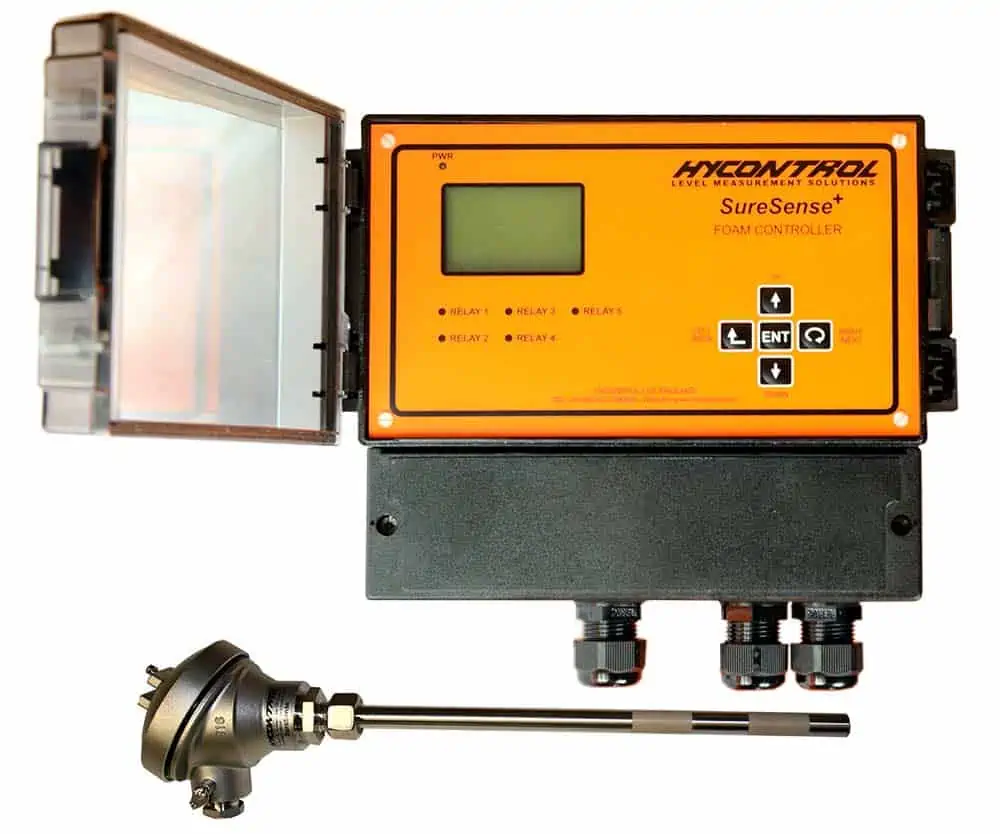The formation of foam within bioreactors has been an industry-wide issue for decades. The foaming tendency of the nutrient media used to cultivate bacteria, algae or animal cells in the production of antibiotics, vaccines, steroids and other products can create problematic operational issues. Furthermore, the drive to achieve higher viable cell densities for greater product yields has increased process oxygen demand. To support this higher oxygen demand, agitation and aeration rates have also increased, leading to even more foam generation.
Foaming has several undesirable consequences: cell entrapment within the foam, cell damage caused by the bubbles within the foam bursting, reduction of gas transfer rates from the headspace, and over-pressuring of the bioreactor due to clogged vent filters, to name but a few.
It is common to control foam formation within reactor vessels with antifoam additive chemicals. Antifoam chemicals work by reducing the surface tension of the liquid films that form the bubbles within the foam, causing them to more rapidly break down and dissipate. However, there are potential adverse effects—such as toxic effects on metabolism, lowering of cell gas uptake, and reduction of yield—from the addition of antifoam chemicals. At laboratory scale, these effects can be detrimental to drug discovery programs. At production scale, aside from the cost of the chemicals themselves (which can be significant), they can negatively impact the cost per unit of product. Therefore, it is vital that the addition of these chemicals be minimized as much as possible.
Traditional approaches to controlling foam and optimizing bioreactor conditions result in overdosing of antifoam chemicals.
It is generally understood that reliable monitoring of the presence of foam is key to reducing the amount of antifoam additive used.
Many bioreactor manufacturers offer foam detection sensors, as well as optional associated antifoam addition control systems. However, not all foam detection systems are equal, and manufacturers’ standard systems are often not reliable enough for long periods of unattended processing.
Problems with foam detection systems are typically related to coating and fouling of sensors, and the resulting generation of false positives. Because of this difficulty in automating foam control, it’s common to find that the process of antifoam addition is a manual function—a technician sees foam forming and adds chemical to knock it back. The foam detector in the reactor vessel is relegated to being used as a backup to visual observation. When antifoam chemicals are manually added in this manner, overdosing is not uncommon. In addition, different technicians may interpret the quantity of additive needed differently, leading to repeatability concerns with batches and experiments.
To mitigate repeatability issues, antifoam addition can be mandated and systematized in batch instructions, with the chemical being added at set intervals or times during a batch, regardless of whether it is needed or not. These instructions can err on the side of caution, again leading to an overdose condition.
There is a wide variety of foam detection and measurement instrumentation available.
Instrumentation deployed for foam detection are usually single-point, switch-type devices that trigger when a foam layer reaches them. Sensitivity high enough to detect light foam products is an essential requirement. In bioreactors, the fouling and coating of foam detection probes is very common, so it is equally important to differentiate between sensor fouling/coating versus foam rising inside the bioreactor. Typical measurement techniques utilized are based upon conductivity, ultrasonics, and impedance.
Conductivity Switch
Conductivity switches consist of a single probe that is installed above the level of the liquid in the bioreactor. There is an active electrode at its tip, and its shaft is covered with an isolating material such as PTFE to isolate it from the rest of the bioreactor structure. The instrument is set to sense when the tip of the probe changes from being in air to being very close to or in a foam layer. Unfortunately, conductivity switches are notorious for false positives due to the process medium fouling of the probe, creating a conductive bridge between the active electrode and ground circuits. A false-positive condition like this can cause a de-foaming additive dosing pump to continuously dispense until the false detection event is recognized. In extreme cases, false positives like these can lead to the entire process batch being ruined.
Ultrasonic Gap Switch
Ultrasonic gap switches operate by sending an acoustic signal across a gap formed by a Y-shaped sensor. Within the sensor are two piezoelectric crystals, one transmitting and the other receiving. The transmitted signal is produced at a magnitude that is too low to travel across the gap when in air or gas. But when a liquid phase fills the gap, the acoustic signal can travel through the liquid phase to the receiving crystal. This change in signal level is used to indicate the presence of foam.
Unfortunately, because foam is mostly composed of trapped gas, it is not as good a medium for acoustic signal conductivity as liquid is, so the detection threshold level in these devices has to be set at the most sensitive level in order to see foam. This can give rise to false positives when no foam is present, often from media splashing around in the vessel. Furthermore, after a foaming event, material left on the sensor surfaces can cause attenuation of the acoustic signal, preventing switching when the foam level reaches the sensor. In this state, foam can pass the control point, fouling filters and possibly damaging other equipment and instrumentation.
Impedance IMA Foam Detection Probes
Impedance devices work in a similar way to conductivity devices, except that rather than monitoring for a change in dielectric, they operate by passing a small alternating current through the foam being detected, and this is used to measure impedance. The impedance of the material being sensed is used to determine when foam is present.
Foam detection systems based upon impedance are available with IMA (intelligent multi-action) measurement circuits that can detect and mitigate fouling/coating on the sensor, preventing false positives and ensuring reliable measurement where other techniques fail. Systems fitted with this type of probe can be operated unattended in a fully automatic mode and will use only the amount of antifoam additive necessary to keep foam at bay within the vessel.
The benefits of this approach are obvious and significant, which is why we almost always advise the incorporation of Hycontrol Suresense+ sensors—which pioneer the use of IMA measurement circuits—into any foam detection and control solution.
Because SureSense+ systems are designed to be resistant to fouling and buildup, and a single unit can incorporate data from up to three sensing points in one or more vessels, the result is a foam control system that can automated to a far greater degree than approaches based on other methodologies, while eliminating the most significant problems associated with foam control.
Finding the balance between too little and too much foam management.
Studies have shown that the dosing of antifoam chemicals has both positive and negative effects on fermentation and cell culture processes. On the positive side, dispersion of foam increases transfer rates of headspace gases into the media, prevents blockage of vent filters and ensures other equipment such as gas concentration instruments can operate unimpaired. On the other hand, excessive use of antifoam chemicals has been demonstrated to negatively impact cell growth and therefore protein product yields in upstream bioprocessing.
It is a fine balance between too much antifoam additive and not enough. Automated systems using reliable sensing technology can help maintain the balance between high product yield and reduction of foam to prevent issues while the bioreactor is in operation.
Below are some specific questions we often receive from clients in the biopharmaceutical industry, and how the use of automatic foam control methods can remedy these issues.
How can bioreactor processing yields be increased?
Foaming in a bioreactor during processing is a normal occurrence, but can cause serious problems, such as reducing cell growth by lowering the surface area contact between the growth media and the bioreactor headspace, lowering oxygen transfer rates. On the other hand, when antifoam chemicals are used in large amounts, they can also reduce batch production rates due to interaction with the cells in the process.
The best approach is to reduce the amount of antifoaming chemicals added to the process by installing a foam detection probe that will trigger the dispensing of antifoam chemical only when needed. This will prevent the level of antifoam chemicals present from reaching concentrations that reduce cell interaction, while also preventing foam from interfering with cell growth.
The bioreactor filter becomes clogged with foam, causing the pressure relief valve (PRV) to vent. How can this be prevented?
Excessive foam build-up can clog filters and create vessel over-pressures outside of acceptable limits. To prevent foam from reaching the vent filter(s), install a reliable foam detection system that allows for real-time monitoring and action against foam buildup in the bioreactor. This will protect against product loss, prevent filter clogging, and ensure the PRV does not operate with the attendant mess this can cause.
Are there bioreactor probes that don’t give false positive readings when they are coated or fouled?
Reliable foam control requires reliable foam detection. False positives result in overuse of antifoam chemicals leading to increased cost and potential reductions in yield.
Most bioreactor probes are simple devices that, once fouled with process media, can create these false positive readings. However, Hycontrol SureSense+ probes feature a unique sensing method that allows them to control for coating and fouling, and continue to provide reliable foam detection even when completely covered with process material.


